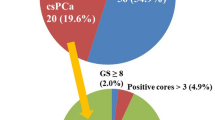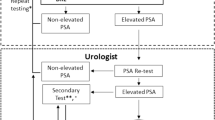Abstract
The clinical significance of atypical glands suspicious for malignancy (atypia) on prostate biopsy is unclear. We studied a cohort of 139 patients with atypia who underwent repeat prostate biopsy. We analyzed clinical and pathological variables that may be associated with cancer on repeat biopsy. Cancer was diagnosed in 41 (29%) of patients with atypia: 26 of 41 (66%) were Gleason 6, 20% were Gleason 7 and 7% were Gleason 8 (Gleason <6 not reported). There were no significant associations of age, race, family history, PSA, PSA density (PSAd), number of previous biopsies or time to repeat biopsy with cancer diagnosis. In multivariate regression, histological inflammation was associated with an 85% decreased probability of cancer on repeat biopsy (odds ratio; OR 0.15; 95% confidence interval; CI 0.04–0.57; P=0.04). Radical prostatectomy was performed in 14 of 41 (34%) patients with cancer; 6 (43%) were Gleason sum ⩾7, 3 (21%) were pT3a and 1 (7%) had lymph node metastases. In conclusion, inflammation was independently associated with a significantly decreased risk of cancer on repeat biopsy. However, some patients with initial atypia have higher-risk prostate cancer. Additional studies are needed to elucidate these associations.
This is a preview of subscription content, access via your institution
Access options
Subscribe to this journal
Receive 4 print issues and online access
$259.00 per year
only $64.75 per issue
Buy this article
- Purchase on Springer Link
- Instant access to full article PDF
Prices may be subject to local taxes which are calculated during checkout
Similar content being viewed by others
References
Epstein JI, Herawi M . Prostate needle biopsies containing prostatic intraepithelial neoplasia or atypical foci suspicious for carcinoma: implications for patient care. J Urol 2006; 175: 820–834.
Iczkowski KA, MacLennan GT, Bostwick DG . Atypical small acinar proliferation suspicious for malignancy in prostate needle biopsies: clinical significance in 33 cases. Am J Surg Pathol 1997; 21: 1489–1495.
Abouassaly R, Tan N, Moussa A, Jones JS . Risk of prostate cancer after diagnosis of atypical glands suspicious for carcinoma on saturation and traditional biopsies. J Urol 2008; 180: 911–914; discussion 914.
Borboroglu PG, Sur RL, Roberts JL, Amling CL . Repeat biopsy strategy in patients with atypical small acinar proliferation or high grade prostatic intraepithelial neoplasia on initial prostate needle biopsy. J Urol 2001; 166: 866–870.
Renshaw AA, Santis WF, Richie JP . Clinicopathological characteristics of prostatic adenocarcinoma in men with atypical prostate needle biopsies. J Urol 1998; 159: 2018–2021; discussion 2022.
Parsons JK, Partin AW . Clinical interpretation of prostate biopsy reports. Urology 2006; 67: 452–457.
Brimo F, Vollmer RT, Corcos J, Humphrey PA, Bismar TA . Outcome for repeated biopsy of the prostate: roles of serum PSA, small atypical glands, and prostatic intraepithelial neoplasia. Am J Clin Pathol 2007; 128: 648–651.
Finne P, Finne R, Auvinen A, Juusela H, Aro J, Määttänen L et al. Predicting the outcome of prostate biopsy in screen-positive men by a multilayer perceptron network. Urology 2000; 56: 418–422.
Kranse R, Beemsterboer P, Rietbergen J, Habbema D, Hugosson J, Schröder FH . Predictors for biopsy outcome in the European Randomized Study of Screening for Prostate Cancer (Rotterdam region). Prostate 1999; 39: 316–322.
Andriole GL, Bostwick DG, Brawley OW, Gomella LG, Marberger M, Montorsi F et al. Effect of dutasteride on the risk of prostate cancer. N Engl J Med 2010; 362: 1192–1202.
de la Taille A, Antiphon P, Salomon L, Cherfan M, Porcher R, Hoznek A et al. Prospective evaluation of a 21-sample needle biopsy procedure designed to improve the prostate cancer detection rate. Urology 2003; 61: 1181–1186.
Jones JS . Management of rising prostate-specific antigen following a negative biopsy. Curr Opin Urol 2010; 20: 198–203.
Patel AR, Jones JS, Rabets J, DeOreo G, Zippe CD . Parasagittal biopsies add minimal information in repeat saturation prostate biopsy. Urology 2004; 63: 87–89.
Rabets JC, Jones JS, Patel A, Zippe CD . Prostate cancer detection with office based saturation biopsy in a repeat biopsy population. J Urol 2004; 172: 94–97.
Nelson WG, De Marzo AM, Isaacs WB . Prostate cancer. N Engl J Med 2003; 349: 366–381.
Karakiewicz PI, Benayoun S, Bégin LR, Duclos A, Valiquette L, McCormack M et al. Chronic inflammation is negatively associated with prostate cancer and high-grade prostatic intraepithelial neoplasia on needle biopsy. Int J Clin Pract 2007; 61: 425–430.
Abdel-Meguid TA, Mosli HA, Al-Maghrabi JA . Prostate inflammation. Association with benign prostatic hyperplasia and prostate cancer. Saudi Med J 2009; 30: 1563–1567.
Di Silverio F, Gentile V, De Matteis A, Mariotti G, Giuseppe V, Luigi PA et al. Distribution of inflammation, pre-malignant lesions, incidental carcinoma in histologically confirmed benign prostatic hyperplasia: a retrospective analysis. Eur Urol 2003; 43: 164–175.
Turley RS, Hamilton RJ, Terris MK, Kane CJ, Aronson WJ, Presti Jr JC et al. Small transrectal ultrasound volume predicts clinically significant Gleason score upgrading after radical prostatectomy: results from the SEARCH database. J Urol 2008; 179: 523–527; discussion 527–528.
Turley RS, Terris MK, Kane CJ, Aronson WJ, Presti Jr JC, Amling CL et al. The association between prostate size and Gleason score upgrading depends on the number of biopsy cores obtained: results from the Shared Equal Access Regional Cancer Hospital Database. BJU Int 2008; 102: 1074–1079.
Kramer G, Mitteregger D, Marberger M . Is benign prostatic hyperplasia (BPH) an immune inflammatory disease? Eur Urol 2007; 51: 1202–1216.
Quintar AA, Doll A, Leimgruber C, Palmeri CM, Roth FD, Maccioni M et al. Acute inflammation promotes early cellular stimulation of the epithelial and stromal compartments of the rat prostate. Prostate 2010; 70: 1153–1165.
Klein EA, Silverman R . Inflammation, infection, and prostate cancer. Curr Opin Urol 2008; 18: 315–319.
Martinez-Fierro ML, Leach RJ, Gomez-Guerra LS, Garza-Guajardo R, Johnson-Pais T, Beuten J et al. Identification of viral infections in the prostate and evaluation of their association with cancer. BMC Cancer 2010; 10: 326.
Urisman A, Molinaro RJ, Fischer N, Plummer SJ, Casey G, Klein EA et al. Identification of a novel Gammaretrovirus in prostate tumors of patients homozygous for R462Q RNASEL variant. PLoS Pathog 2006; 2: e25.
Brausi M, Castagnetti G, Dotti A, De Luca G, Olmi R, Cesinaro AM . Immediate radical prostatectomy in patients with atypical small acinar proliferation. Over treatment? J Urol 2004; 172: 906–908; discussion 908–909.
Nickel JC, True LD, Krieger JN, Berger RE, Boag AH, Young ID . Consensus development of a histopathological classification system for chronic prostatic inflammation. BJU Int 2001; 87: 797–805.
Author information
Authors and Affiliations
Corresponding author
Ethics declarations
Competing interests
Dr Parsons receives compensation as consultant for AMS and as an investor of Urigen. Dr Kopp, Mr Shiau, Dr Wang-Rodriguez, Ms Palazzi-Churas, Dr Silberstein, Dr Derweesh, and Dr Sakamoto declare no conflict of interest.
Rights and permissions
About this article
Cite this article
Kopp, R., Parsons, J., Shiau, J. et al. Prostate atypia: clinical and pathological variables associated with cancer diagnosis on repeat biopsy. Prostate Cancer Prostatic Dis 14, 149–154 (2011). https://doi.org/10.1038/pcan.2010.53
Received:
Revised:
Accepted:
Published:
Issue Date:
DOI: https://doi.org/10.1038/pcan.2010.53



